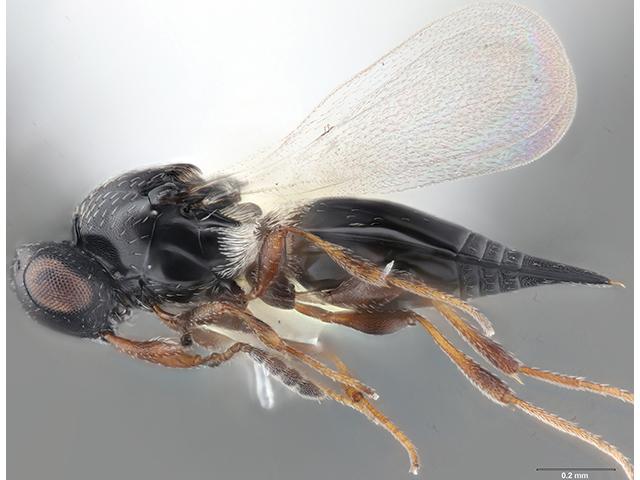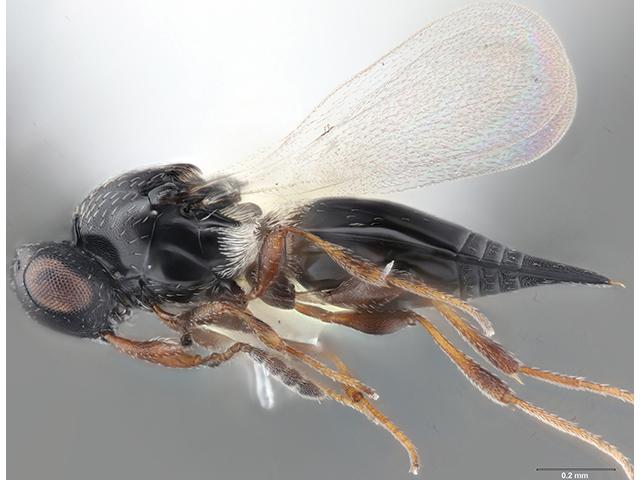Production Blog
A Real-life Wasp Superhero Battles Soybean Pest
JEFFERSON CITY, Mo. (DTN) -- In the Marvel Cinematic Universe, characters Scott Lang and Hope Van Dyne wear special suits that shrink them into the insect superheroes known as Ant-Man and the Wasp. In Minnesota, entomologists have discovered a new species of tiny parasitic wasp that could prove to be a real-life superhero for soybean farmers, no special suit required.
A team led by researchers from the University of Minnesota discovered a previously undescribed parasitic wasp while investigating options for managing soybean gall midge, a small fly whose larvae can cause yield-robbing damage in soybeans. After confirming the wasp was a new species, they named it Synopeas maximum due to its relationship to soybean (Glycine max) and soybean gall midge (Resseliella maxima).
According to Amelia Lindsey, University of Minnesota assistant professor of entomology and member of the team that discovered Synopeas maximum, wasps in this genus are considered highly host-specific. They typically lay their eggs into the eggs or larvae of the gall midges.
"Wasp development is delayed until the host insect reaches pupation, at which point the wasp will rapidly develop, killing the host," she told DTN. "How many wasp generations occur each season or year will likely be dependent on the development time of the host and how many host generations there are per year. There is potential for multiple wasp generations per growing season, as has been seen for other Synopeas. This is a question we are currently pursuing in ongoing efforts."
P[L1] D[0x0] M[300x250] OOP[F] ADUNIT[] T[]
The wasps, which are the size of a grain of sand, were discovered in soybean plants taken from fields in Rock County, Minnesota, which shares borders with both Iowa and South Dakota. Robert Koch, University of Minnesota Extension entomologist, said the geographic range of Synopeas maximum is currently unknown. A project is underway to sample multiple fields in Minnesota, Iowa and Nebraska to determine how widespread this species is and how its rates of parasitism of the soybean gall midge vary within fields and during the growing season vary across the region. The team will also look for other species of parasitic wasps attacking soybean gall midge.
First documented in Nebraska in 2011, soybean gall midge adults look like small, long-legged flies. They deposit eggs in the small cracks at the base of the soybean plant above the soil surface. The orange larvae that hatch then feed inside the stem, eventually cutting off nutrient flow that causes the soybean plant to starve and die.
Soybean gall midge can cause significant yield losses. According to published research, losses can be up to 100% for the first 30 meters from the field edge, with losses of 17% to 31% further into the field. The pest's known range is expanding in the Midwest, and management options remain limited. Insecticides have provided relatively low and inconsistent levels of control and may reduce biological control by other insects. Koch noted that parasitic wasps are generally highly susceptible to insecticides.
"I suspect that foliar applications of many of the insecticides, especially broad-spectrum insecticides like pyrethroids or organophosphates, used in soybean for pests like soybean gall midge or soybean aphid would be detrimental to Synopeas maximum adults," he said.
With greater understanding of parasitic wasps and other predatory insects that feed on soybean gall midge, the entomologists hope to develop management recommendations for promoting populations of these beneficial insects in fields and the natural pest control they contribute.
In addition to the Lindsey and Koch, the team that discovered Synopeas maximum includes University of Minnesota graduate student Gloria Melotto, Jessica Awad from the State Museum of Natural History in Stuttgart, Germany, and Elijah Talamas from the Florida Department of Agriculture and Consumer Services. The team published a paper about the new species in the Journal of Hymenoptera Research, which can be found here: https://jhr.pensoft.net/….
For more information about this pest, visit the Soybean Gall Midge Alert Network here: www.soybeangallmidge.org.
Jason Jenkins can be reached at jason.jenkins@dtn.com
Follow him on Twitter @JasonJenkinsDTN
(c) Copyright 2023 DTN, LLC. All rights reserved.






Comments
To comment, please Log In or Join our Community .